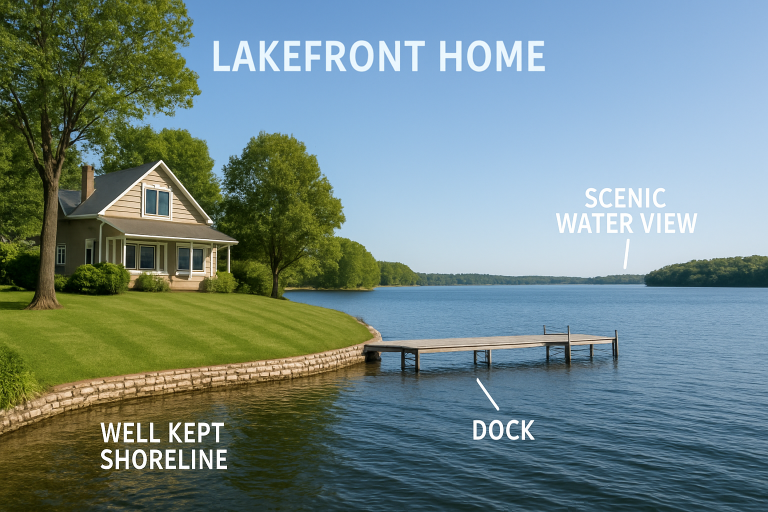
Investing in lakefront property is an exciting opportunity that pairs stunning vistas and recreational potential with attractive long-term value. These premier locations offer unique benefits—from unmatched tranquility to direct water access—but also require buyers to consider practical realities. Before you commit, consulting with Seattle WA real estate experts Lake & Company Real Estate can help guide you through the nuances of this high-stakes market, ensuring you make informed choices.
Lakefront living comes with added expenses, regulatory considerations, and distinct environmental risks. Understanding both the costs and advantages will help maximize your lifestyle and investment goals while minimizing surprises along the way. Truly successful ownership means looking beyond the view and weighing shoreline integrity, utility availability, and the well-being of your family and the ecosystem.
Financial Factors to Keep in Mind
Market Trends and Premium Pricing
Lakefront homes routinely command premium price tags compared to their inland counterparts. This is fueled by limited supply and high buyer demand for water views and proximity to recreational areas. According to U.S. News Real Estate, buyers should also consider factors such as shoreline maintenance, insurance requirements, and local regulations before making a purchase. Waterfront homes have outpaced general market appreciation over the past several years, signaling that—when chosen wisely—these investments can yield more substantial returns. However, prices vary depending on location, available amenities, and overall economic conditions, making thorough market research and local insight essential.
Property Taxes and Valuation
Homes in desirable areas often come with higher annual property taxes. Local governments regularly reassess waterfront properties, so buyers need to understand how frequently these evaluations occur and whether they are based on sale price or periodic reviews. Examining county records and budget reports ahead of time helps you anticipate ongoing costs and avoid surprises after completing your purchase.
Insurance Coverage and Liabilities
Owning a lakefront home requires specialized insurance, especially flood coverage, which may be mandatory if the property lies within a FEMA-identified flood zone. Even if it doesn’t, additional protection against storms and erosion is wise, as waterfront locations are more vulnerable to weather-related damage. You may also need liability insurance for docks, boats, or water activities, which can significantly increase your premiums.
Evaluating Shoreline Conditions and Water Access
The usability and long-term value of a lakefront property hinge on the quality of its shoreline. A sandy, gently sloping bank is ideal for swimming, while rocky or marshy edges may limit recreational access and curb appeal. Depth is another vital metric, especially if boating is part of your vision—shallow, muddy segments may require dredging or construction permits for dock installation, which are tightly regulated by many municipalities. Understanding whether any prior improvements, such as seawalls or docks, exist can impact both immediate usability and the property’s market value over time.
Additionally, pay attention to signs of erosion, invasive plant growth, or sediment buildup, as these can compromise safety and require costly remediation work. If in doubt, engage a shoreline specialist for a thorough assessment prior to purchasing.
Determining Utility Availability and Infrastructure
Ready access to electricity, water, sewage, and high-speed internet significantly influences your enjoyment and the practicality of year-round living lakeside. Some properties, particularly in rural or newly developed areas, may lack modern utility connections or require significant investment to install septic tanks, drill wells, or run power lines. These costs can add up quickly—sometimes offsetting any “bargain” buying price—so always review these gaps and budget for solutions before you close.
Future plans, such as expanding the home or adding amenities (like hot tubs or docks with electrical lifts), also hinge on reliable utility access. Don’t hesitate to request documentation from the seller or the county, or to schedule a site visit with contractors who understand the requirements for lakeside infrastructure.
Assessing Environmental Factors and Flood Risks
Owning property at the water’s edge carries the responsibility to protect both your investment and the surrounding ecosystem. Start by researching whether your desired property lies in a recognized flood zone; if so, calculate the implications for insurance, construction, and emergency preparedness. Wetland protections, endangered species habitats, and shoreline conservation laws may dictate—or limit—how you can modify, develop, or maintain the property. Local conservation agencies often provide mapping and permitting guidance for these sensitive areas.
Erosion is another persistent challenge that can undermine both land and structures. Proactive solutions such as riprap, native plantings, or engineered barriers often require permits and can carry hefty price tags. Comprehensive due diligence ensures you remain in compliance and can plan for appropriate safeguards before a problem arises.
Lifestyle and Long-Term Goals
Recreation and Water Activities
Lakefront homes are coveted not only for their scenic views but also for their instant access to endless recreational opportunities. Fishing, kayaking, paddleboarding, and swimming are all at your doorstep. This lifestyle provides a unique blend of serenity and adventure, making it easy to enjoy nature, entertain guests, and create lasting memories with friends and family. Whether you want to relax on your private beach or launch a boat for an afternoon on the water, lakefront living adapts to all ages and interests.
Community and Family Legacy Aspects
Beyond personal enjoyment, many buyers envision their lakefront home as a legacy property—an anchor for gatherings spanning generations. Vibrant local communities often center on boating clubs, fishing tournaments, and neighborhood events, which can enhance your sense of belonging and connection. Prioritizing both your day-to-day needs and the property’s long-term appeal—should you pass it on or sell—ensures that your investment pays personal and financial dividends far into the future.
Conclusion
Lakefront property promises a rare combination of investment potential, natural beauty, and lifestyle enrichment. To protect your financial well-being and maximize enjoyment, give careful thought to premium pricing, fluctuating utility needs, environmental hazards, and the unique character of lakeside communities. Due diligence—combined with trustworthy, local guidance—will ensure your dream of lakefront living translates to security, satisfaction, and value for years to come.